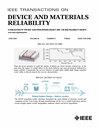A Consistent Analytical Method to Assess Reliability of Redundant Safety Instrumented Systems
IF 2.5
3区 工程技术
Q2 ENGINEERING, ELECTRICAL & ELECTRONIC
IEEE Transactions on Device and Materials Reliability
Pub Date : 2022-07-27
DOI:10.1109/TDMR.2022.3193922
引用次数: 0
Abstract
The significance of determining Safety Integrity Level (SIL) has grown substantially in numerous industry sectors since the publication of international standard for functional safety (IEC61508). To detect SIL using IEC61508, the demand mode must first be recognised. However, there is not any 100% accurate method to identify the demand mode. Design engineers must assume the demand mode based on their assessment of the likely number of failures each year in the system under consideration, referred to as demand rate. This signifies that a defective demand mode assumption leads to an incorrect SIL determination. In addition, the formulas provided by the IEC standards for the SIL determination did not include the demand duration. The majority of prior publications in the literature relied on SIL determination using IEC61508. As a result, the literature suffers from the constraints of the IEC61508 standard, which include ignoring demand duration and uncertainty in assuming the system’s demand mode for determining SIL. This paper addresses the aforementioned issues in literature through proposing a scenario based-formula to calculate Hazardous Event Frequency (HEF) using Markov process for safety system with dual redundancy. The HEF calculated can then be utilized to select SIL while considering the demand duration and obviating the requirement to use the SIS demand mode. The results demonstrated that the proposed method provides higher accuracy in calculating the HEF value compared to the existing traditional formulas.一种评估冗余安全仪表系统可靠性的一致性分析方法
自国际功能安全标准(IEC61508)发布以来,确定安全完整性等级(SIL)的重要性在许多行业领域都有了实质性的增长。要使用IEC61508检测SIL,必须首先识别需求模式。然而,没有任何100%准确的方法来确定需求模式。设计工程师必须根据他们对所考虑的系统中每年可能出现的故障数量的评估(称为需求率)来假设需求模式。这表明有缺陷的需求模式假设导致了不正确的SIL确定。此外,IEC标准提供的SIL测定公式不包括需求持续时间。先前文献中的大多数出版物依赖于使用IEC61508进行SIL测定。因此,文献受到IEC61508标准的约束,包括忽略需求持续时间和在假设系统需求模式来确定SIL时的不确定性。本文针对上述文献问题,提出了一种基于场景的基于马尔可夫过程的双冗余安全系统危险事件频率(HEF)计算公式。计算出的HEF可用于选择SIL,同时考虑需求持续时间并避免使用SIS需求模式的要求。结果表明,与现有的传统计算公式相比,该方法在计算HEF值时具有更高的精度。
本文章由计算机程序翻译,如有差异,请以英文原文为准。
求助全文
约1分钟内获得全文
求助全文
来源期刊

IEEE Transactions on Device and Materials Reliability
工程技术-工程:电子与电气
CiteScore
4.80
自引率
5.00%
发文量
71
审稿时长
6-12 weeks
期刊介绍:
The scope of the publication includes, but is not limited to Reliability of: Devices, Materials, Processes, Interfaces, Integrated Microsystems (including MEMS & Sensors), Transistors, Technology (CMOS, BiCMOS, etc.), Integrated Circuits (IC, SSI, MSI, LSI, ULSI, ELSI, etc.), Thin Film Transistor Applications. The measurement and understanding of the reliability of such entities at each phase, from the concept stage through research and development and into manufacturing scale-up, provides the overall database on the reliability of the devices, materials, processes, package and other necessities for the successful introduction of a product to market. This reliability database is the foundation for a quality product, which meets customer expectation. A product so developed has high reliability. High quality will be achieved because product weaknesses will have been found (root cause analysis) and designed out of the final product. This process of ever increasing reliability and quality will result in a superior product. In the end, reliability and quality are not one thing; but in a sense everything, which can be or has to be done to guarantee that the product successfully performs in the field under customer conditions. Our goal is to capture these advances. An additional objective is to focus cross fertilized communication in the state of the art of reliability of electronic materials and devices and provide fundamental understanding of basic phenomena that affect reliability. In addition, the publication is a forum for interdisciplinary studies on reliability. An overall goal is to provide leading edge/state of the art information, which is critically relevant to the creation of reliable products.
 求助内容:
求助内容: 应助结果提醒方式:
应助结果提醒方式:


